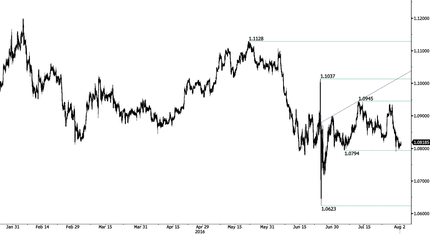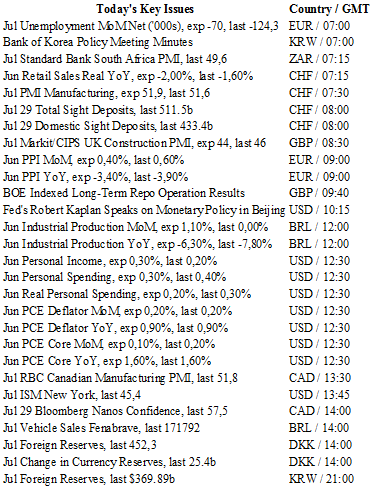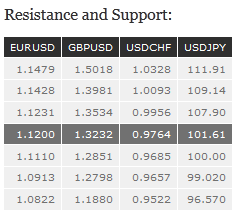BoK releases July’s MPC minutes, inflation disappoints
Since the beginning of the year, the South Korean won has been rallying strongly against the US dollar as investors continue to chase higher yields in a low rate environment.
The South Korean economy outperformed most of its peers in the second quarter as it grow at a solid pace of 3.2%y/y (versus 3.0% expected), while the unemployment rate fell to 3.6% in June from 3.7% in the previous month. Therefore, the BoK held fire at its July meeting as it maintained its repo rate at 1.25% on hold after slashing 25bps in June.
At first glance, the picture looks fine, but the country’s outlook is not that bright, as exports fell another 10.2%y/y in July compared to -2.7% in June and -6.7% median forecast. Imports contracted 14%y/y (verse -10.5% exp. and -8% previous). Consequently, the trade surplus slid to $7.8bn versus $8.2bn median forecast and $11.5bn in June.
Overall, the data suggests that the recent appreciation of the won has seriously dampened the country’s exports. The minutes of the July’s BoK meeting indicated that the MPS is waiting for further indication regarding the effects of the previous rate cut before cutting rates further.
However, since central banks across the planet continue to ease their monetary policy further and since the Fed is expected to remain on the sidelines for a while yet, the BoK may have no choice but to join the currency battle and cut its repo rate in order to prevent further KRW appreciation.
In addition, the inflation data released today showed that price pressure is struggling to move towards the 2% target. Headline CPI printed at 1.6%y/y, missing consensus of 1.7%.
USD/KRW is trading at a 19-month low as it hit 1,106.37 on Tuesday morning. On the downside, a support lies at 1,097.47 (low from June 22nd), while on the upside a resistance can be found at around 1,200 (previous highs and psychological level).
Swiss data indicates economic weakness but CHF to appreciate
Further evidence that economic growth in Switzerland is suffering due to broad uncertainties surrounding Brexit and unsupportively strong CHF was released today. Switzerland manufacturing sector decelerated according to July manufacturing PMI report, which declined to 50.1 from 51.6 (51.9 expected). This drop continues a worrying trend seen since April’s peak.
With exports driving demand for manufacturing, the uncompetitive CHF is clearly not helping lagging growth (highlighted most clearly in the collapse of the Swiss watch industry). In addition, the domestic consumer has failed to show-up to offset external weakness. Swiss June real retail sales y/y continued to collapse, contracting -3.9% (notional terms -4.6%) following prior -1.6% read (faster than the -2.0% declined expected). On a monthly basis retail sales showed at 0.5% decline from May.
Despite Swiss economic weakness, we continue to expected safe-haven investors to drive demand for CHF (to the anxiety of Swiss corporate and the SNB). However, within the current macro environment, Switzerland acts like the preverbal “canary in the coal mine”.
With broad trade network weakness in this externally exposed nation indicates deep economic concerns ahead globally. Despite concerned economic outlook we expect CHF to further appreciate and EUR/CHF to break psychological support at 1.0800 with a 1.0636 target.
EUR/CHF - Moving sideways

EUR/USD EUR/USD is moving sideways below resistance. A break of the resistance implied by the top of the range (around 1.1186) is needed to negate the current bearish bias. Hourly support can be located at 1.1149 (15/07/2016 high). An hourly support lies at 1.1056 (27/07/2016 base), while a key support stands at 1.0965. In the longer term, the technical structure favours a very long-term bearish bias as resistance at 1.1714 (24/08/2015 high) holds. The pair is trading in range since the start of 2015. Strong support is given at 1.0458 (16/03/2015 low). However, the current technical structure since last December implies a gradual increase.
GBP/USD GBP/USD continues to move within its channel range. Hourly resistance is located at 1.3315 (15/07/2016 high). Stronger resistance is located at 1.3534 (29/06/2016 high). Support located at 1.3058 (26/07/2016 low). The long-term technical pattern is negative and favours a further decline as long as prices remain below the resistance at 1.5340/64 (04/11/2015 low see also the 200-day moving average). Key support at 1.3503 (23/01/2009 low) has been broken and the road is wide open for further decline.
USD/JPY USD/JPY is moving sideways after break of 103.39 support. The short-term technical structure is negative as long as prices remain below the hourly resistance at 103.91 (13/07/2016 low). Hourly supports can be found at 102.04 (intra low). We favour a long-term bearish bias. Support is now given at 96.57 (10/08/2013 low). A gradual rise towards the major resistance at 135.15 (01/02/2002 high) seems absolutely unlikely. Expected to decline further support at 93.79 (13/06/2013 low).
USD/CHF USD/CHF is pausing after taking out support at 0.9685. The short-term technical structure is negative as long as prices remain below the hourly resistance at 0.9764 (14/07/2016 low). Initial resistance lies at 0.9703 (intraday high). In the long-term, the pair is still trading in range since 2011 despite some turmoil when the SNB unpegged the CHF. Key support can be found 0.8986 (30/01/2015 low). The technical structure favours a long term bullish bias since last December.

